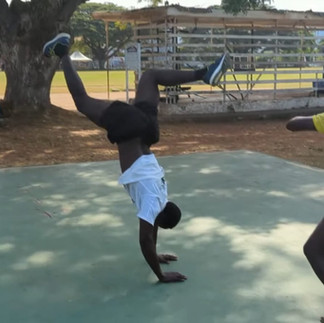Victor Kouassi is a communications professional with a scientific background. He was born and raised in London, UK and also spent part of his childhood in Ghana where he is originally from.

He now lives in Lausanne, Switzerland. He shares his journey from having an aversion to playing sports to becoming a lover of the Brazilian sport of capoeira.

In this post he explores the African influences in capoeira and its potential to return back to Africa through a new generation of sport lovers.
Sport was never for me, growing up. I found playing football or tennis impossible. So I am pretty proud to say that I am now immersed in an incredibly active form of martial art called capoeira, which has improved my physical and mental wellbeing but also deepened my connection to my African roots.

When we think of capoeira, we think of Brazil but there is some uncertainty about its origins with some claiming that the sport emerged from the cultures of millions of Africans that were forcibly brought to Brazil.
One of the theories is that its roots lie in Angola in southern Africa from a dance known as N’golo (dance of the zebras).

This dance has kicks and dodges similar to capoeira and may have evolved into other similar martial arts such as Danmye Ladja which can be found in Martinique in the Caribbean.
As Brazil’s enslaved African populations grew, capoeira also flourished.
According to Nestor Capoeira, author of ‘The Little Capoeira Book’, the martial art gave Africans in Brazil a sense of nationality and self-confidence. It also helped to create small cohesive group but was also seen as a threat as fighters became agile and dangerous.
As a result, from 1814 onwards, slave masters and overseers started to repress and prohibit capoeira and other forms of African cultural expression and by 1892, capoeira was outlawed, according to Capoeira Las Vegas.
The influence of music
Efforts to formalise the sport led to it becoming legal by 1940, according to the publication Capoeira Las Vegas. Another prevalent theory linked to the survival of capoeira is that it was disguised as a dance so that it could be practiced unbeknownst to the white slave owners. Music helped to achieve that.
All capoeira is dictated by musical rhythms. The pandeiro, a tambourine, made with goat skin, is usually played together with the atabaque, a tall drum played with the hands, and the berimbau, is a one stringed instrument with a gourd attached, which looks very much like a bow with a long metal string wound on a stick.

The Frafra people of Ghana have a similar instrument called the jinjeram. It is played with a smaller stick that gives it a distinct sound, which is amplified by a hollowed-out calabash at the bottom of the instrument.
During a game, people form a circle or a roda, sing and clap in a call-and-response style, which has African origins, while music plays and the capoeiristas compete.
I remember going to my first roda in London and shouting back ‘O lê lê’ in that call-and-response style and finding that the more I responded using my Ghanaian accent, the more authentic my responses sounded.
So, although capoeira is a combat sport, music and capoeira are so intertwined that the melodies must be obeyed as if it were a dance.
And that is one of the things I admire about this sport –its refusal to place itself on either side between being a dance or a fight. It is both and neither really. It is what it is.
My capoeira journey so far
I’ve been a capoeirista for eight years and from the beginning of my journey, I found that the more I read about capoeira, the more captivated I became.
There are broadly three types of styles: Capoeira Angola, Capoeira Regional and Capoeira Contemporarie. Vicente Ferreira Pastinha or Mestre Pastinha developed ‘Capoeira Angola’ - a style with slower movements that are made closer to the ground but with blows that some argue are harsher on the opponent.
Manuel dos Reis Machado, more commonly known as Mestre Bimba, created ‘Capoeira Regional’ in Salvador de Bahia. This style is usually played upright and has more explosive kicks. I play Capoeira Contemporarie, which is a modern interpretation and fusion of traditional Capoeira Angola and Capoeira Regional.
I attended a few classes in London after moving to Switzerland, found Association Capoeira Lausanne – an academy in the French-speaking region of Vaud.
For more than 30 years, this academy has been led by Mestre Paulao Suiça, who came to Switzerland from Minas Gerais in south-eastern Brazil.
I was amazed to find so many references to West African cultures at this Swiss establishment.
The expansive room contained large drums atabaques which look like slimmer versions of the atumpan. There are photos of the orixas (gods) on the walls. These gods and goddesses originate from Yoruba culture and are exalted by Brazil’s African diaspora.
The values of respect and acknowledging everyone as you enter the academy, especially to the mestre, were strongly familiar to practices in Ghana.
As someone who despised any form of sport growing up, learning how to leverage movements of my body efficiently has been difficult but hugely rewarding.
I have developed and improved my body coordination, agility, and stamina all being taught in French - a language I am not as fluent is as English or Twi. And my interest in the sport also led me to learn about the growth of the sport in my Mother country.
Bringing capoeira to Ghana
On my last trip to Ghana, in November 2023, I was determined to find capoeristas. Luckily, I met Michael Drmazado - a physics student at the University of Ghana who has been learning capoeira from Pedro Gil Herranz.
Pedro is a mestre from Spain who started Ascende - an NGO, which promotes the empowerment of children in Ghana’s Volta Region through education and sports such as capoeira.
Michael was introduced to capoeira through a friend. He describes the sport as “not just a martial art but a whole community on its own which promotes unity, boldness, time management as well as focus and leadership skills” – qualities he believes Ghanaians could benefit from.
While in Accra, I trained with Michael at the University of Ghana’s Legon campus. He has a high standard of playing, weaving handstands in between his swift ‘armada’ (a back crescent kick in capoeira.)
Michael feels that capoeira and other Afro-Brazilian cultural practices could fit neatly alongside those in Ghana and talks about the possibility of working the dances of kpalongo, borbor and adowa into maculele - a stick-fighting dance that capoeiristas often play which also has African roots.
Now eight years on, I've come so far in my capoeira journey, but it's only the beginning. I would be lying if I said there haven’t been moments where I have questioned why I still put myself through the intense sessions. But capoeira has instilled in me the importance of persistence and having a growth mindset. I do not allow myself to be weighed down by what I cannot do or compare myself to others, but I keep working to be better than I once was.
In a sort of virtuous cycle, I have become motivated to take on other activities to improve my capoeira such as running to boost my agility and stamina, and weightlifting for enhanced strength.
My mestre in Lausanne says occasionally that his next holiday will be in Ghana, expressing his wish to discover my much-loved country.
He believes that an increased connection to it would even improve my capoeira. I too would like to see capoeira flourish in much the same way that sports such boxing, karate, and taekwondo, are gaining ground in Ghana and across Africa.
It would be an honour to introduce him to my land and for him to be able to teach many of us about this art form that can connect the diaspora with the continent that birthed it.
The contents of this page are produced by Victor Kouassi for AKADi Magazine and cannot be reproduced without permission.
Read about other Ghanaians Abroad here: https://www.akadimagazine.com/home/categories/ghanaians-abroad







Comments